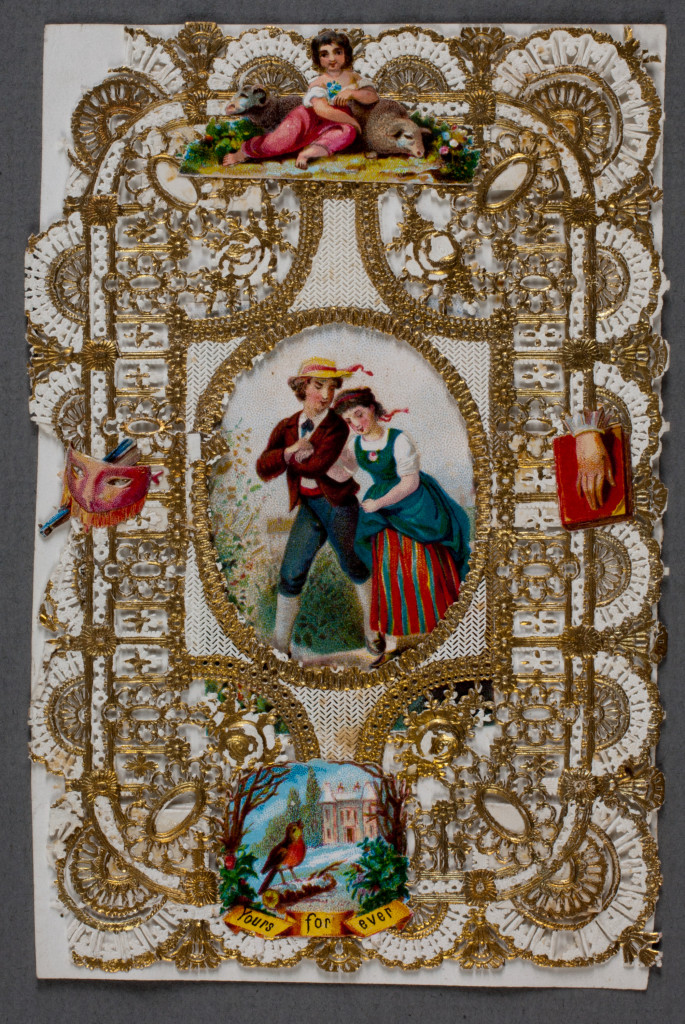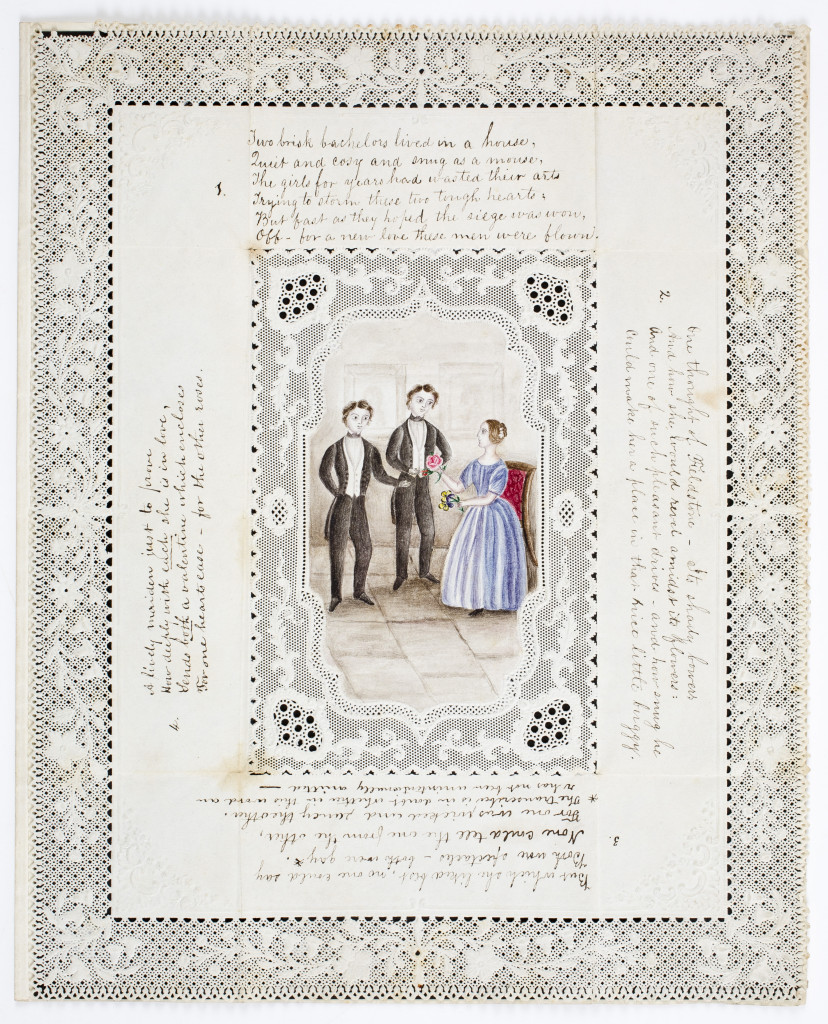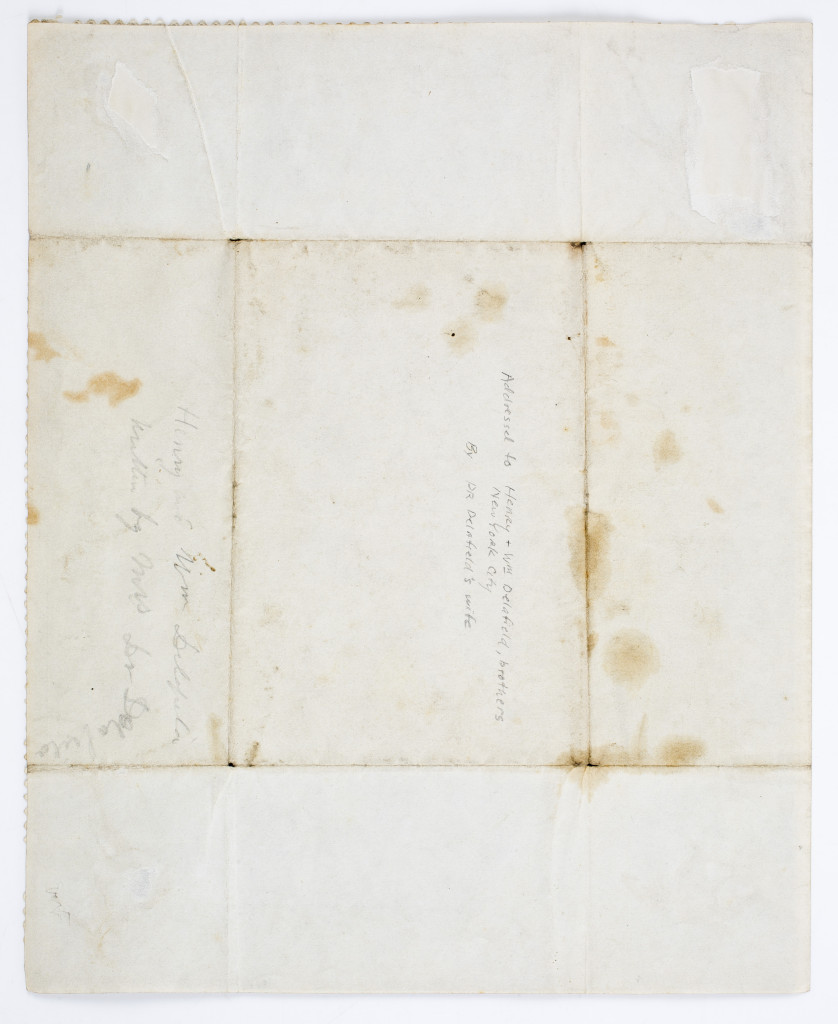 This week, AAS was fortunate to receive a hand-made, circa 1830, valentine as a donation. Society member George K. Fox of California presented the valentine to AAS President Ellen Dunlap at an event at the San Francisco Book Club celebrating the Society’s receipt of the National Humanities Medal.
This week, AAS was fortunate to receive a hand-made, circa 1830, valentine as a donation. Society member George K. Fox of California presented the valentine to AAS President Ellen Dunlap at an event at the San Francisco Book Club celebrating the Society’s receipt of the National Humanities Medal.
The Society has a large and representative collection of over 3,000 American printed and manuscript valentines. We have excellent holdings of lacy, colorful, heart-bedecked cards made by Worcester-resident Esther Howland (at right and you can see more here), lots of comic or vinegar valentines designed for your “frenemies,” and plenty of printed material related to Valentine’s Day, including party invitations, manuals for assistance in writing love messages, and periodicals with articles about the customs and traditions popular in the nineteenth century.
So when the California gift was presented and the staff on the West coast excitedly texted the news, we wondered how anything could possibly improve our already great holdings? Well, this gift does! The valentine is fantastic and is also well-documented. The soft, embossed lace  paper features a lovely watercolor image of two young men and a lady holding some flowers, and four stanzas of original poetry written in the surrounding borders. The valentine was likely made by Elinor Elizabeth Delafield, the wife of Dr. Edward Delafield, around 1830 when she and the two men depicted were all in their late thirties. The two young men in the image are her brothers-in-law, the identical twins Henry and William Delafield, born in 1792. Both brothers served in the War of 1812 and later worked as bankers and merchants in New York, where Elinor and Edward also lived. They were notorious bachelors and, according to the family history, were inseparable. The first stanza of the poem states: “Two brisk bachelors lived in a house, / Quiet and cozy and snug as a mouse. The girls for years had wasted their arts / Trying to storm these two tough hearts.” The poem chides the twins for being fickle with love, casting aside one lady after another, and also scoffs at unnamed young ladies and their attempts to coerce the twins into wedlock. The poem has a very breezy and amusing rhythm that highlights the mischief for which the twins were known—the brothers would often surreptitiously change partners during balls and no one would notice, a fact the poem includes, stating: “None could tell the one from the other / For one was wicked and saucy the other.” The woman in the valentine holds a tri-color pansy and a rose, both of which are still associated with Valentine’s Day—the rose for love and the pansy (or heart’s ease) for contentment.
paper features a lovely watercolor image of two young men and a lady holding some flowers, and four stanzas of original poetry written in the surrounding borders. The valentine was likely made by Elinor Elizabeth Delafield, the wife of Dr. Edward Delafield, around 1830 when she and the two men depicted were all in their late thirties. The two young men in the image are her brothers-in-law, the identical twins Henry and William Delafield, born in 1792. Both brothers served in the War of 1812 and later worked as bankers and merchants in New York, where Elinor and Edward also lived. They were notorious bachelors and, according to the family history, were inseparable. The first stanza of the poem states: “Two brisk bachelors lived in a house, / Quiet and cozy and snug as a mouse. The girls for years had wasted their arts / Trying to storm these two tough hearts.” The poem chides the twins for being fickle with love, casting aside one lady after another, and also scoffs at unnamed young ladies and their attempts to coerce the twins into wedlock. The poem has a very breezy and amusing rhythm that highlights the mischief for which the twins were known—the brothers would often surreptitiously change partners during balls and no one would notice, a fact the poem includes, stating: “None could tell the one from the other / For one was wicked and saucy the other.” The woman in the valentine holds a tri-color pansy and a rose, both of which are still associated with Valentine’s Day—the rose for love and the pansy (or heart’s ease) for contentment.
 The valentine was found in a scrapbook kept by Susan Delafield Parrish (or Parish), a younger sister to the twins, and is inscribed on the back “Henry and Wm. Delafield / Valentine by Mrs. Dr. Delafield” (see right). Possibly, the twins presented it to Susan after Elinor’s death in 1834 and Susan put it in the family scrapbook. William never married, and died at age 62 in 1853. Henry married at age 73 and died ten years later, in 1875. The family genealogist recalled that the “boys” as they were called for their entire lives had “many family and personal friends, an excellent reputation, the good will of all, and plenty of determination.” We are so pleased to have their valentine, made by an obviously doting sister-in-law, preserved at AAS.
The valentine was found in a scrapbook kept by Susan Delafield Parrish (or Parish), a younger sister to the twins, and is inscribed on the back “Henry and Wm. Delafield / Valentine by Mrs. Dr. Delafield” (see right). Possibly, the twins presented it to Susan after Elinor’s death in 1834 and Susan put it in the family scrapbook. William never married, and died at age 62 in 1853. Henry married at age 73 and died ten years later, in 1875. The family genealogist recalled that the “boys” as they were called for their entire lives had “many family and personal friends, an excellent reputation, the good will of all, and plenty of determination.” We are so pleased to have their valentine, made by an obviously doting sister-in-law, preserved at AAS.
